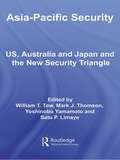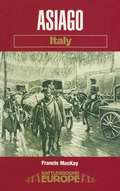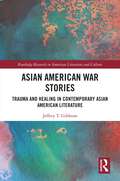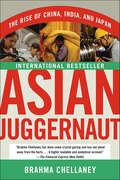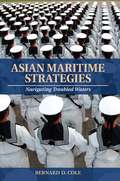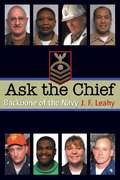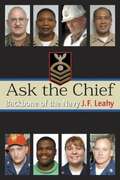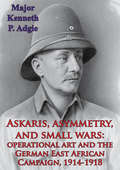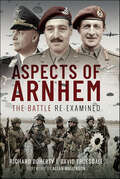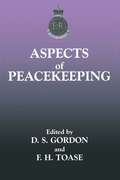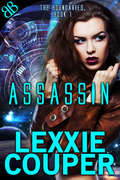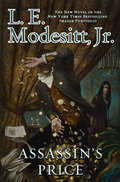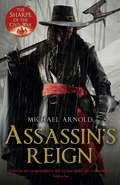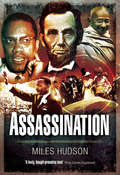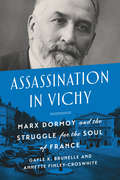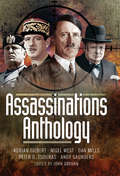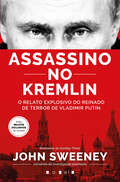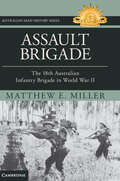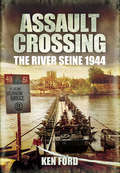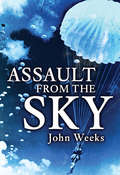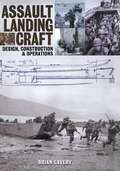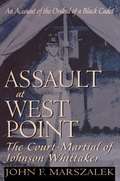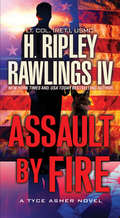- Table View
- List View
Asia-Pacific Security: US, Australia and Japan and the New Security Triangle (Asian Security Studies)
by William T. Tow Mark J. Thomson Yoshinobu Yamamoto Satu P. LimayeThe aim of this book is to explore the implications stemming from the recent upgrading of Australia-Japan-US security interactions and the implications for Asia-Pacific regional security that these represent. While a fully functioning trilateral security alliance binding Australia, Japan and the United States is unlikely to materialise or 
Asiago: Italy (Battleground Europe)
by Francis MackayA battlefield guide to the scene of an Austro-Hungarian attack on the British Corps sector of the Allied front line on the Asiago Plateau, forty miles north of Venice in Northern Italy, on 15/16 June 1918. This comprehensive and attractive guidebook describes the terrain, the forces involved and the fighting, including the action leading to the award of two Vcs.
Asian American War Stories: Trauma and Healing in Contemporary Asian American Literature (Routledge Research in American Literature and Culture)
by Jeffrey Tyler GibbonsAsian American War Stories examines contemporary Asian American literature that considers both the short-term and the long-term effects of war, trauma, and displacement on civilians, as well as the ways that individuals seek healing in the face of suffering. Through the works of contemporary writers like Chang-rae Lee, Ocean Vuong, Nora Okja Keller, Julie Otsuka, Lan Cao, and Lawson Inada, this book explores the ways that recent Asian American literature reflects the enduring consequences of America’s wars in Asia at the individual and collective levels. The book also considers the journeys that individuals take as they pursue healing of their traumatic wounds.
Asian Juggernaut: The Rise of China, India, and Japan
by Brahma ChellaneyIn Asian Juggernaut, the revelatory and important International Bestseller by Brahma Chellaney, a renowned authority on Asia’s political and economic development offers an incisive and insightful analysis of the region’s pivotal role on the world stage. Examining the rise of China, India, and Japan as preeminent powers and their key position in the global future, Asian Juggernaut is a book that must be read by anyone interested in the shape of tomorrow’s world.
Asian Maritime Strategies
by Bernard D. ColeThis book is concerned with both the national security concerns of Asian maritime nations and the security of the Asian maritime commons. These are defined as the Pacific and Indian Oceans and associated seas, bays, and gulfs, with their included sea lines of communication (SLOCs). The most useful geographical designation for maritime Asia is the "Indo-Pacific." Bernard Cole provides both a survey of the maritime strategies of the primary nations of the Indo-Pacific region and an evaluation of the domestic and international politics that drive those strategies. The United States, Canada, Russia, Japan, North Korea, South Korea, China, the Philippines, Brunei, Indonesia, Vietnam, Singapore, Malaysia, Myanmar, India, Pakistan, Iran, the smaller Indian Ocean and Persian Gulf states are all surveyed and analyzed. The United States, Japan, China, and India not surprisingly draw the most attention, given their large modern navies and distant strategic reach. The author concludes that the United States remains the dominant maritime power in this huge region, stretching from Canada to the Persian Gulf, despite its lack of a traditionally strong merchant marine. U.S. maritime power remains paramount, due primarily to its dominant navy. The Chinese naval modernization program deservedly receives a good deal of public attention, but Cole argues that on a day-to-day basis the Japanese Maritime Self-Defense Force, as its navy is named, is the most powerful maritime force in Far Eastern waters, while the modernizing Indian Navy potentially dominates the Indian Ocean. In fact, a focus of this work is the exemplary description of all the region's navies, with the author noting the naval arms race that is underway, particularly in the area of submarine acquisition. Cole is careful to couch this phenomenon in the regional concerns about Chinese naval expansion and the desire to ensure a continued, massive U.S. naval presence. The current naval developments in the region evince elements of a naval arms race, but lack the coherent maritime strategies to make naval developments dangerous to regional peace and security. Most telling will be whether United States power and focus remain on the region, while adjusting to continued Chinese maritime power in a way acceptable to both nations. No other current or recent work provides such a complete description of the Indo-Pacific region's navies and maritime strategies, while analyzing the current and future impact of those forces.
Ask and Tell
by Steve EstesDon't Ask, Don't Tell" was the directive of President Clinton's 1993 military policy regarding gay and lesbian soldiers. This official silence continued a collective amnesia about the patriotic service and courageous sacrifices of homosexual troops. Ask and Tell recovers these lost voices, offering a rich chronicle of the history of gay and lesbian service in the U.S. military from World War II to the Iraq War. Drawing on more than 50 interviews with gay and lesbian veterans, Steve Estes charts the evolution of policy toward homosexuals in the military over the past 65 years, uncovering the ways that silence about sexuality and military service has affected the identities of gay veterans. These veteran voices--harrowing, heroic, and on the record--reveal the extraordinary stories of ordinary Americans, men and women who simply did their duty and served their country in the face of homophobia, prejudice, and enemy fire. Far from undermining national security, unit cohesion, or troop morale, Estes demonstrates, these veterans strengthened the U.S. military in times of war and peace. He also examines challenges to the ban on homosexual service, placing them in the context of the wider movement for gay rights and gay liberation. Ask and Tell is an important compilation of unheard voices, offering Americans a new understanding of the value of all the men and women who serve and protect them.The official silence mandated by the 1993 "Don't Ask, Don't Tell" policy continued a collective amnesia about the patriotic service and courageous sacrifices of homosexual troops. Ask and Tell recovers these lost voices, offering a rich chronicle of the history of gay and lesbian service in the U.S. military from World War II to the Iraq War. Drawing on more than 50 interviews with gay and lesbian veterans, Steve Estes charts the evolution of policy toward homosexuals in the military over the past 65 years, uncovering the ways that silence about sexuality and military service has affected the identities of gay veterans. These veteran voices--harrowing, heroic, and on the record--reveal the extraordinary stories of ordinary Americans, men and women who simply did their duty and served their country in the face of homophobia, prejudice, and enemy fire. -->
Ask the Chief
by John F. LeahyWhenever sailors are confronted with 'unsolvable' problems--be it a fouled anchor or paint that won't dry--they often throw up their hands and exclaim, 'We'd better ask the Chief.' That refrain, heard for generations throughout the Navy, is the theme for Jack Leahy's newest book. Written at sea, his book provides a compelling picture of the Chief Petty Officer's community in the U.S. Navy.As a guest of the Chief Petty Officer's mess aboard USS George Washington during Operation Enduring Freedom, Leahy was granted complete and unfettered access to all areas of the massive carrier and the other ships in her battle group. He interviewed nearly one hundred Navy Chiefs from the aviation, surface, submarine, and special warfare communities and recounts their stories of daily life at sea. In doing so, he presents the true backbone of the modern Navy: the wisdom, character, and dignity of the Chief Petty Officer's community. This book of contemporaneous oral history follows the format that proved so successful with Leahy's earlier book on Navy boot camp. Color photographs help bring the story to life.
Ask the Chief: Backbone of the Navy
by J. F. LeahyAs a guest of the chief petty officers mess aboard USS George Washington during Operation Enduring Freedom, Leahy was granted complete and unfettered access to all areas of the massive carrier as well as the other ships in her battle group.
Askaris, Asymmetry, And Small Wars: Operational Art And The German East African Campaign, 1914-1918
by Major Kenneth P. AdgieThis monograph analyzed whether Lieutenant Colonel Paul von Lettow-Vorbeck used operational art to defeat British forces in the East African campaign of World War I. British forces were superior in quantity of men and equipment, but slow moving and heavily dependent on secure lines of communication. Lettow-Vorbeck's forces maintained an asymmetric advantage in mobility, knowledge of terrain, and responsive logistics. An analogy was suggested that the U.S. Army in the twenty-first century is similar to British forces in 1914, and the nation's future adversaries could potentially use Lettow-Vorbeck's unconventional warfare and asymmetric tactics woven together in a comprehensive campaign plan.This monograph reviewed the origins and characteristics of operational art. The Army's emerging doctrine, Student Text 3-0, Operations defines operational art as the "use of military force to achieve strategic goals through the design, organization, integration, and conduct of theater strategic, campaigns, major operations, and battles" and serves as the entry point for discussion. A synthesis of Shimon Naveh and James Schneider's theories revealed five primary characteristics of operational art and was used as the criteria to evaluate the research question. The five characteristics were: operational objectives, operational maneuver, disruption, operational approach, and operational logistics. The East African campaign was analyzed from the perspective of Lettow-Vorbeck linking his strategic aim of forcing the British to commit forces to a secondary theater of operations to his limited resources. The four-year campaign was divided into three phases based on Lettow-Vorbeck's operational objectives and the correlation of forces. Significant tactical vignettes were examined as part of an overarching campaign plan. Finally, this monograph considered how the U.S. Army would fight an asymmetric enemy in a similar environment.
Aspects of Arnhem: The Battle Re-examined
by Richard Doherty David TruesdaleAlmost 80 years on the battle for the Arnhem Rhine crossing remains controversial. Opinion on its justification and success differs widely. This superbly researched book, written by two acknowledged experts, takes a wide-ranging examination of Operation Market Garden from the strategic, operational and tactical level. The role of the Allied commanders involved is scrutinized with surprising results. For example, US General Brereton’s pivotal role has seldom been mentioned, yet he is revealed as responsible for choosing landing and drop zones. The record of airborne forces, both German and Allied, prior to September 1944 raises questions and the doubt that many senior commanders, including Eisenhower, had as to their effectiveness is highlighted. The parts played by VIII and XII Corps of Second Army and General Dempsey, its Commander are scrutinized, as are the actions of local commanders and troops on the ground. Both those with a deep interest in military history and the layman will find much to inform and satisfy them in this valuable and at times provocative account.
Aspects of Peacekeeping (The Sandhurst Conference Series)
by D. S. Gordon F. H. ToaseThe nature of UN operational involvement in the practical management of conflict has evolved dramatically since the end of the Cold War. The post-Cold War liberation of the Security Council, the subsequent paralysis in its decision-making competence, and the apparent dilution of the concept of sovereignty as a prohibition on intervention have been principal factors in the evolving fortunes of UK peace-support operations. This evolving environment has had profound implications for the way in which the humanitarian community, the United Nations and military forces engaged under a UN flag have reacted to peace-support operations. This book explores contemporary peace-support operations and examines many of the principal challenges that now confront those charged, in different ways, with bringing peace to war-torn societies. In particular, this volume looks at the evolving nature of military, UN and humanitarian non-governmental organization's intervention in these complex conflicts. It also explores how these organizations relate to one another and the way in which a division of labour is determined.
Assassin (The\boundaries Ser. #1)
by Lexxie CouperExperience the boundaries of space, where alien drug lords blight the landscape, sex is a reward and a weapon, and the lines between friend and foe are blurred. Assassin, by award winning sci-fi paranormal author Lexxie Couper, is Book 1 of The Boundaries series, a thrilling ride to distant planets where assassination is the key to winning the war on drugs.Boundary Guardian Zeric Arctos knows trouble when he sees it--and Raavelian sex-slave Jaienna Ti screams all sorts of trouble. Tracking a nefarious Bliss dealer, Zeric must stay focused on the job, something almost impossible to do with Jaienna close by. To make matters worse, the seductive Raavelian brings out the 'animal' in him--an ancient blood curse he has struggled to control his whole life. The beast now threatens to consume him, and Jaienna's intoxicating kisses make the primitive call so much harder to resist.Jaienna Ti is out for revenge. And she'll stop at nothing to achieve it. Posing as a sex-slave isn't the worst thing she's done--she is, after all an Intel-Patrol Corp termination agent, albeit a rogue one--but it's definitely one of the more interesting roles she's assumed. And it gets even more interesting when Zeric Arctos 'rescues' her.Surely being an intergalactic sexual assassin has to come with some perks, right?This erotic sci-fi paranormal romance contains wild, explosive sex in space and is not intended for readers under the age of 18.Previously Published: (2011) 5x5 Publishing | (2006) Changeling Press
Assassin's Price (The Imager Portfolio #11)
by L. E. Modesitt Jr.Assassin's Price is the eleventh book in the bestselling, epic fantasy series the Imager Portfolio by L. E. Modesitt, Jr. and the third book in a story arc which began with Madness in Solidar and Treachery's Tools. Six years have passed since the failed uprising of the High Holders, and the man behind the conspiracy is where the rex and Maitre Alastar can keep an eye on him. Charyn has come of age and desperately wants to learn more so he can become an effective rex after his father—but he’s kept at a distance by the rex. So Charyn sets out to educate himself—circumspectly. When Jarolian privateers disrupt Solidar’s shipping, someone attempts to kill Charyn’s younger brother as an act of protest. Threatening notes following in the wake of acts of violence against the rex and his family, demanding action—build more ships or expect someone to die. The Imager Portfolio: #1 Imager / #2 Imager’s Challenge / #3 Imager’s Intrigue / #4 Scholar / #5 Princeps / #6 Imager’s Battalion / #7 Antiagon Fire / #8 Rex Regis / #9 Madness in Solidar / #10 Treachery’s Tools / #11 Assassin’s Price Other series by this author: The Saga of Recluce, The Corean Chronicles, The Spellsong Cycle, The Ghost Books, The Ecolitan Matter At the Publisher's request, this title is being sold without Digital Rights Management Software (DRM) applied.
Assassin's Reign: Book 4 of The Civil War Chronicles (Stryker)
by Michael ArnoldAssassin's Reign, the fourth in The Civil War Chronicles, Michael Arnold's acclaimed series of historical thrillers, sees battle-scarred hero Captain Stryker, 'the Sharpe of the Civil War', in the fight of his life.'Stands in comparison with the best of Cornwell' Yorkshire PostThe forces of King Charles are victorious; their Parliamentarian enemies in deep crisis. In the west, the crucial port city of Bristol has fallen, and Royalist eyes fall quickly upon neighbouring Gloucester. Its walls are weak, its garrison under strength, and its governor - Sir Edward Massie - suspected of harbouring sympathy for the King.Stryker and his men are with the army as it converges on Gloucester, still reeling from the loss of a close friend at the bloody Battle of Stratton. Ordered to infiltrate the rebel city on a mission to discover whether Massie will indeed surrender, Stryker reluctantly embarks upon his most desperate mission yet. But Gloucester's defenders are more resolute than any had imagined, and catastrophe soon befalls him. With his life seemingly forfeit, Stryker is spared by an unlikely saviour; Vincent Skaithlocke, his former commander. The mercenary has returned to England to fight for Parliament, and offers Stryker his protection. As old friends adjust to life fighting for opposing sides, Stryker begins to question his own loyalties . . . but a chance discovery makes him realise that all in Gloucester is not what it seems, for a hidden menace threatens his own life, and that of King Charles himself.
Assassination
by Miles HudsonThe assassination of political, religious and military leaders, often dictators, is frequently seen as the short cut to solving a particular problem. The author takes issue with this argument. Examining a series of linked assassinations together with their causes and effects, he seeks to demonstrate that in many cases the killings have produced unforeseen and unintended consequences that all too often result in the opposite result to that desired. His case studies, arranged intriguingly in pairs, cover such diverse characters as Julius Caesar and Thomas Becket, Gandhi and Jesus Christ, Tsar Alexander II and Abraham Lincoln, Michael Collins and Field Marshal Sir Henry Wilson, and Martin Luther King and Malcolm X.This is an absorbing, controversial and informative study.
Assassination in Vichy: Marx Dormoy and the Struggle for the Soul of France
by Gayle Brunelle Stephanie Annette Finley-CroswhiteDuring the night of 25 July 1941, assassins planted a time bomb in the bed of the former French Interior Minister, Marx Dormoy. The explosion on the following morning launched a two-year investigation that traced Dormoy’s murder to the highest echelons of the Vichy regime. Dormoy, who had led a 1937 investigation into the “Cagoule,” a violent right-wing terrorist organization, was the victim of a captivating revenge plot. Based on the meticulous examination of thousands of documents, Assassination in Vichy tells the story of Dormoy’s murder and the investigation that followed. At the heart of this book lies a true crime that was sensational in its day. A microhistory that tells a larger and more significant story about the development of far-right political movements, domestic terrorism, and the importance of courage, Assassination in Vichy explores the impact of France’s deep political divisions, wartime choices, and post-war memory.
Assassinations Anthology: Plots and Murders That Would Have Changed the Course of WW2
by Peter G. Tsouras Adrian Gilbert Nigel West Andy Saunders Dan MillsA fascinating look at what might have happened had historical assassination attempts succeeded. If Hitler had died at any stage in the Second World War, would Germany have immediately sued for peace, or would the generals have taken over and fought a far more practical war than the obdurate Führer? Equally intriguing is the possible failed assassination attempt on General de Gaulle on British soil. Who, one wonders, was behind that scheme, and how would Anglo-French relations have developed if he had been killed? In Assassinations Anthology, a number of well-known authors and historians look at past events where key individuals were involved in either attempts on their lives, or strange incidents occurred which, had they led to their deaths, might have radically affected the outcome of the war. Events surrounding Hitler and Operation Valkyrie, Stalin and Jan Smuts are investigated, as well as the peculiar circumstances relating to the theft of a valuable Gainsborough painting. Just how great a role did the Government&’s Chief Whip, David Margesson, play in persuading the MPs to accept the unpopular Winston Churchill as Prime Minister, and what would have happened if Margesson had been killed when the Gainsborough disappeared? It is fascinating stuff. Grounded in actual events, the various scenarios portrayed in this collection examine the likely chain of events that would have followed if the assassination attempts had succeeded. A few inches, a few minutes—that was all the difference between life and death, and between the past that we know and one that we can only imagine.
Assassino no Kremlin: O Relato Explosivo do Reinado de Terror de Vladimir Putin
by John SweeneyUm livro que põe a descoberto o governo impiedoso e a máquina de matar do Kremlin, e coloca questões urgentes sobre como o mundo deve responder. Com 30 anos de experiência em ambientes de guerra, o premiado jornalista John Sweeney faz neste livro um relato da ambição desmedida e da desumanidade de Vladimir Putin, desde os golpes levados a cabo no coração da Rússia até às atrocidades cometidas pelo exército russo na Chechénia, à anexação da Crimeia e à invasão da Ucrânia, um dos atos mais hediondos de agressão da história moderna. Recorrendo a testemunhos daqueles que sofreram sob o poder de Putin, vemos o heroísmo da oposição russa, a bravura da resistência ucraniana e a brutalidade com que o Kremlin responde a atos de desafio, assassinando ou pondo fora do caminho os críticos e opositores, não se detendo perante nada para atingir os seus objetivos imperialistas. «As palavras têm poder. Vladimir Putin tem medo da verdade.» ALEXEI NAVALNY, líder da oposição russa, atualmente preso pelo regime do Kremlin «Uma obra que traça o percurso sangrento de Vladimir Putin.» THE TIMES «Um livro que escrutina os pecados do líder do regime da Rússia.» IPAPER «Vladimir Putin é um presidente tão perverso e desordeiro quanto José Estaline.» BORIS NEMTSOV, líder da oposição russa assassinado em 2015 «Ninguém no mundo vai perdoar Vladimir Putin por matar pessoas inocentes.» VOLODYMYR ZELENSKY, presidente da Ucrânia «Um ditador, empenhado em reconstruir um império, nunca destruirá o amor de um povo pela liberdade.» JOE BIDEN, presidente dos Estados Unidos da América
Assault Brigade: The 18th Australian Infantry Brigade in World War II (Australian Army History Series)
by Matthew MillerThe Australian Army served in numerous theatres and campaigns throughout World War II, earning distinction and at times facing significant challenges. During the Pacific War, the infantry brigade, as an intermediate formation commanding multiple infantry battalions and numerous attached units, was key in Australian efforts to secure victory. The 18th Infantry Brigade participated in a variety of combat operations with a range of allies allowing it rare experience among Australian units. It's involvement in operations from Europe to the Middle East and onto the Pacific ensured that it was one of the most modern brigades at the close of the war. Assault Brigade examines the challenges and development of the Australian Army's 18th Infantry Brigade throughout World War II. It investigates a series of campaigns fought across the South West Pacific Area, highlighting lessons learnt and adaptations implemented as a result of each battle.
Assault Crossing: The River Seine 1944
by Ken FordThe assault crossing of the River Seine by the British 43rd (Wessex) Division in August 1944 remains one of the most important operations of the closing stages of the Second World War. Once the obstacle of the great river had been overcome, General Horrocks unleashed the armor of XXX Corps on their historic dash across northern France and Belgium.Assault Crossing Ken Fords classic account of this critical battle—is the story of one British division pitted against one German division. On one side, a fully equipped, battle-hardened unit made up of soldiers from the ancient Kingdom of Wessex, backed by some of the best artillery in the world and supported by tanks. On the other side, a much-depleted, second-rate, static division of men of various nationalities conscripted to fight a war for Germany that was already lost. On paper the British were assured of success, but between the two opposing armies lay the Seine 680 feet of open water, overlooked by high chalk cliffs riddle with defensive strong points. The Germans were waiting.In hindsight, the battle was described as an epic operation and used as an example to train future generations of soldiers. In reality, as with most battles, it was something of a shambles, lurching from crisis to crisis until the eventual bridgehead was secured.In his graphic narrative Ken Ford gives a fascinating insight into the planning of the operation and the confusion of the battlefield, and he records, using eyewitness testimony, what the battle was really like for the soldiers who were there.
Assault From the Sky: The History of Airborne Warfare 1939-1980s
by John WeeksEx paratrooper John Weeks' exciting eBook is a dramatic history of airborne troops and their most famous actions: Crete, Arnhem, D-Day, the Vietnam War and beyond.Airborne raids caught popular imagination early in the Second World War, when the elite German forces carried out deadly operations deep behind enemy lines. Able to seize and hold objectives before the enemy has time to react, paratrooper assaults were seen as fast, dynamic and potentially devastating. However, they are also unpredictable. Requiring complete surprise, tactical flexibility and a lot of luck to succeed, a daring airborne raid can soon turn into a disaster, as the Allies discovered in Operation Market Garden. Studying the evolution of airborne forces over one of the bloodiest eras in world history, Assault from the Sky looks at the planners, the generals, aircraft, gliders, weapons and the men who created a revolution in modern warfare.
Assault Landing Craft: Design, Construction & Operators
by Brian LaveryThe landing craft assault or LCA was one of the unsung heroes of the Second World War. It took part in practically every amphibious operation from Norway to Normandy and landed around 400,000 men in action conditions, plus many more in training. It was the only serviceable British landing craft at the beginning of the War, and it remained in service until the Suez operation of 1956. It landed the first waves of infantry on the British and Canadian beaches in Normandy in 1944, and Americans on the notorious Omaha Beach. Its far-sighted design of 1938 remains the basis for the landing craft of today.This is the first book devoted to this humble but essential craft. It examines its design history before the War, when amphibious operations were deeply unfashionable. It describes its design and construction with plans that will be useful to modellers and wargamers. It includes information on the role of the crew and the techniques and tactics used in landings. It gives an account of the larger ships which carried it and the life of the sailors and soldiers who travelled in it, with many vivid personal accounts. Finally, it describes its role in the many operations in which it took part, including withdrawals such as Dunkirk and the catastrophic Dieppe raid of 1942.
Assault at West Point, The Court Martial of Johnson Whittaker
by John MarszalekIn "Assault at West Point", John F. Marszalek, the highly acclaimed author of "Sherman: A Soldier's Passion for Order", has written a dramatic account of one of the most momentous trials in American history. Set in the 1880s, this riveting story focuses on Whittaker, a former slave who became the third black to enter West Point. Like his two predecessors, he was ostracized for the entire three years of his training. One morning Whittaker didn't show up for drill. He was found in his room, unconscious, tied tightly to the bed, with blood streaming from his head. In a trial that received major attention from the press, Whittaker was accused of faking the crime to get sympathy from the public and from his professors. Author Marszalek weaves his rich narrative from historical records to tell how Whittaker sought justice against all odds. Now the basis if the Showtime original movie "Assault at West Point", this compelling work brings to life a case that rocked the country and involved the highest reaches of power-- and vividly demonstrates the impact of racism on the fabric of American society.
Assault at West Point: The Court Martial of Johnson Whittaker
by John F. MarszalekIn "Assault at West Point", John F. Marszalek, the highly acclaimed author of "Sherman: A Soldier's Passion for Order", has written a dramatic account of one of the most momentous trials in American history. Set in the 1880s, this riveting story focuses on Whittaker, a former slave who became the third black to enter West Point. Like his two predecessors, he was ostracized for the entire three years of his training. One morning Whittaker didn't show up for drill. He was found in his room, unconscious, tied tightly to the bed, with blood streaming from his head. In a trial that received major attention from the press, Whittaker was accused of faking the crime to get sympathy from the public and from his professors. Author Marszalek weaves his rich narrative from historical records to tell how Whittaker sought justice against all odds. Now the basis if the Showtime original movie "Assault at West Point", this compelling work brings to life a case that rocked the country and involved the highest reaches of power-- and vividly demonstrates the impact of racism on the fabric of American society.
Assault by Fire: An Action-Packed Military Thriller (A Tyce Asher Novel #1)
by H. Ripley Rawlings IV&“A must read!&” —Mark Greaney, #1 New York Times Bestselling Author In the thrilling tradition of Red Dawn and The Dirty Dozen, this action-packed page-turner from Lt. Col. Hunter Ripley &“Rip&” Rawlings IV brings together insider military expertise with riveting suspense as special ops fighters must foil a surprise attack on American soil in a daring novel fans of Brad Thor and Tom Clancy will love! ASSAULT BY SEA U.S. Marine Tyce Asher knew his fighting days were over when he lost his leg in Iraq. He thought he&’d never see action again—but when he hears secret espionage intel that a potential attack from Russia is imminent, Tyce knows he has to do everything he can to stop it. ASSAULT BY LAND With his history in the Middle East and connections to other veterans, Homeland Security enlists Tyce to coordinate reserve fighters and special ops teams to help prepare the nation for an uncertain future… ASSAULT BY FIRE It is a full-fledged potential invasion orchestrated by a Russian military mastermind hellbent on destruction. With no time to lose, Tyce has to enlist every American he can find—seasoned vets, armchair warriors, backwoods hunters, even mountain moonshiners—to help protect their homeland. &“A high powered thriller...unputdownable." —The Real Book Spy
